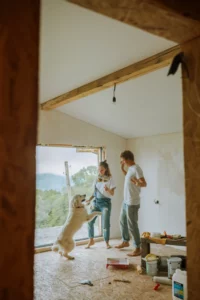How long to wait between coats of paint?
With today’s improved paint technology, paint dries faster than ever, allowing you to finish rooms within a day or two instead of over several days. Still, you want to make sure that your current coat of paint is fully dry before applying the next coat. It can be a delicate balancing act. If you wait too long, the project stretches out longer than is necessary. If you hurry the coats, you risk ruining an otherwise perfect paint job by creating pulls and streaks in still soft, wet paint.
There are three distinct time frames to be aware of when it comes to interior painting with water-based (known as latex) or oil-based (known as alkyd or solvent-based) paint:
- Dry time: the period of time that it takes for wet paint to become tack-free and dry to a light touch of your fingers
- Recoat time: the period of time that it takes for the paint to be thoroughly ready so you can apply another layer of paint
- Cure time: how long it takes for the paint to fully harden so it becomes washable and more touchable, which can sometimes take weeks, depending on the season and your climate
You don’t have to be concerned about a paint’s cure time when it comes to recoating. Stay within the following margins of dry and recoat times for both water-based and oil-based paints for a smooth, flawless finish on your interior walls, trim, and cabinetry.
Paint Calculator: How Much Paint Do I Need?
Our paint – both water and solvent-based – is +/- 6 square metres per litre (surface dependant) per coat.
Water-based paints generally dry faster than solvent-based brushing enamels made in South Africa.
Paint type Drying Time Recoat Time
- Water-based – All finishes 30 – 60 minutes 1 – 2 hours
- Solvent-based – All finishes 8 – 16 hours 24 hours
- Primers 2 – 3 hours 5 hours
Note: Recoat time refers to how much time you should wait to add another coat of paint after you’ve applied the first coat.
Recoat Time for Oil-based Paint
If you’re using oil-based paint on indoor trim; doors; and cabinets, the recoat time differs from water-based paint. Oil-based paint is more durable and takes longer to dry than water-based paint. Oil-based paint may feel dry two to four hours after it’s applied. But recoat a full 24 hours after you’ve painted to make sure the surface is completely dry and ready for another round of paint.
Temperature and Humidity Factors
Even if you’re painting indoors, the temperature of the room and the surface you’re painting affect drying and recoat times. Always apply paint within the temperature parameters specified by the paint manufacturer.
Most water-based paints will optimally dry in a room that’s around 25 degrees Celsius with some humidity in the space.
Oil-based paints will dry best in room temperatures that are above 12 degrees Celsius.
Colder temperatures and excess humidity slow drying time for both water-based and oil-based paints.
Circulating the air with a fan on low quickens paint drying times.
Letting in fresh air through open windows helps the paint drying process along unless it’s too cold, hot, or humid outside.
Application Methods Affect Drying Times
Whether spray, roller, or brush, the mode of paint delivery affects drying time between coats. Spray paint applies thin and evenly which makes it dry a little faster. Rolled-on and brushed-on paint goes on heavier than spray paint and takes the longest amount of time to dry between coats. Always wait for the full drying and recoat times before applying the next coat.

We hope that you found valuable information for your business in this article or thoroughly enjoy your DIY project! If you have any questions, please contact us.
Until next time,
The PC Team.
Some information was scouted from Google


